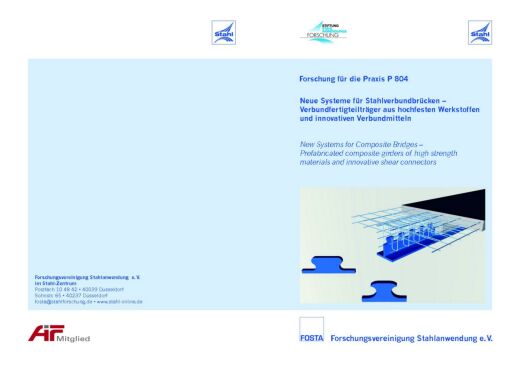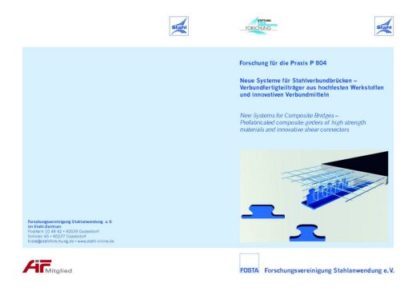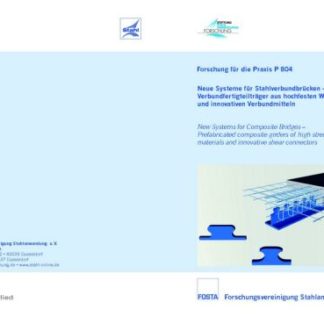Description
P 804 – New Systems for Composite Bridges – Prefabricated composite girders of high strength materials and innovative shear connectors
Prefabricated steel-concrete composite systems have been used more often for bridges with small and medium spans. The safe transfer of static and cyclic shear forces in the composite joint can be efficiently ensured by composite dowels. Advantages are in particular the increased strength, the sufficient deformation capacity, even in high strength concrete, and the simple application in steel sections without upper flange. However, missing provisions in standards and technical approvals for composite dowels complicate the application. Therefore, the main objective of this research project was to prepare a general technical approval open for any design and construction company.
Three selected bridges have been designed to define requirements for composite dowels concerning the bearing capacity and the detailing in prefabricated steel-concrete composite bridge systems. On this basis, supplemented by the main findings of existing static and cyclic push-out respectively beam tests, numerical simulations as well as design concepts, open points are defined and an experimental matrix with 18 static and 6 cyclic push-out tests and 4 cyclic beam tests is assembled.
A ductile behaviour can be detected in the static pushout tests with pry-out and steel failure, if sufficient confinement reinforcement, e.g. stirrups, is arranged. In Tbeam sections with composite dowels used as external reinforcement the load bearing behaviour as well as the deformation capacity can be improved significantly by special confinement stirrups. Without these stirrups, a brittle failure occurs. If composite dowels are arranged in parallel, the distances have to be considered, as the pry-out cones influence each other and the bearing capacity decreases. Without stirrups a minimum distance has to be defined to avoid a negative effect on ductility.
The fatigue design of steel with the structural stress approach is based on stress concentration factors, which were determined by means of strain measurements at the steel teeth in cyclic push-out and beam tests. Here, stresses from longitudinal shear forces and global bending were considered. The measurements showed a good agreement with FE-calculations. Furthermore, the experiments demonstrated that high upper loads can provoke cyclic pry-out cones and damage the composite joint. The assumption of a rigid connection is no longer justified and higher stress can result.
On basis of an extensive database, the scientific results and findings of the own tests as well as numerical simulations, a statistically verified design concept is presented. The design concept includes the static failure modes shearing, pry-out with influence of the distance, vertical splitting and steel. Fatigue of steel and concrete as well as ensuring a rigid composite joint
under cyclic loading is part of the design concept, too.
The research project was carried out at Lehrstuhl für Stahlbau und Leichtmetallbau and at Lehrstuhl für Massivbau der Rheinisch-Westfälisch Technischen Hochschule Aachen, as well as at SSF Ingenieure AG. FOSTA has accompanied the research work and has organized the project funding from the Foundation for Steel Application Research.
Only available in german language.
Authors:
M. Feldmann, M. Gündel, M. Kopp, J. Hegger, J. Gallwoszus, S. Heinemeyer, G. Seidl, O. Hoyer
Published in:
2014




